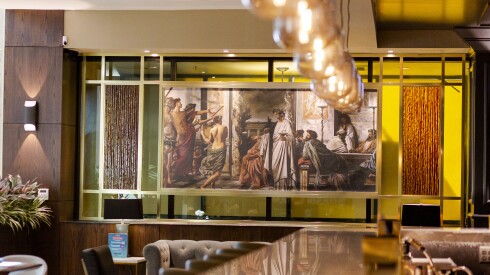Brooklyn-based photographer Jessica Antola has spent the last 10 years capturing images of people from all over the world in their traditional dress. The October 2013 issue of AFAR features a photo essay with some of these shots. They depict places, from Senegal to Burma, where new materials and ideas are mixing with ancient customs to create fascinating frontiers of fashion. Here, Antola shares other memorable scenes from her travels.
WEST PAPUA, INDONESIA
For years, I wanted to travel to West Papua. It’s an area so remote that the first visitors from the outside world were anthropologists who arrived only sixty years ago. I was interested in visiting the highland tribes, such as the Yali.
We had to charter six-seat planes from local missionaries because there were no roads in this area. From the highlands, it was a 10-day walk to the nearest phone.
It seems the Yali have had the same way of dress for thousands of years. Traditionally Yali men wear rattan hoops around their waists and penis gourds, attire which functions well in their damp, mountain environment. Penis gourds, or koteka, are part of their tribal identity. The wearing of the gourds typically starts at a young age because this tradition is physically too difficult for men to adopt as adults.
We had an Indonesian anthropologist/guide who spoke the local dialect. I could see his disappointment when we’d arrive at a village and see only one boy in a penis gourd. The majority of men wore the traditional gourds, but most of the boys wore threadbare shorts and Spiderman or Vodafone T-shirts. The Yali live in an area where they don’t have access to soap to wash nor a way to mend their clothes, therefore, it makes more sense with their lifestyle to wear a gourd and rattan hoops.
In one particular village, the children could see that the men dressed in traditional attire were getting more attention from my camera, so they dressed up like their elders to ensure that they would also be photographed.
I knew that West Papua was probably the most remote place I would ever visit. The people are extremely unique in that they have barely been exposed to the outside world—it was like seeing our Stone-Age ancestors. This trip set my project in motion, because I was seeing firsthand how quickly the traditions were disappearing and changing in one of the most remote corners of the world.
SENEGAL
My images from Senegal are more of a study of textile, color, and fashion. The country felt more cosmopolitan compared to the remote locales I’d previously photographed. The majority of my shots were taken from a moving car. We spent hours driving on the dusty roads, and I was mesmerized by the contrast between the earth tones and the colors worn by the people walking along the roads. By photographing from the moving car, I was able to capture people as they were naturally. The second we stopped the car, and my presence was acknowledged, the moment was lost. I noticed that whether people were hard at work in the villages or walking all day they still had this beautiful sense of style. Senegal was a celebration of color and pattern.
HÀ GIANG PROVINCE, VIETNAM
Hà Giang is in the far north of Vietnam, near the Chinese border. It’s a beautiful, mountainous area and is home to various ethnic minority groups such as the White Hmong, the Black Hmong, the Flower Hmong, and the Yao.
The young women in this photograph are White Hmong, which we know from the white skirts peeking through their ensembles. We were driving on a remote mountain road with hairpin turns and steep cliffs when we saw these two young women walking. I got out of the car to ask their permission to photograph, and they ran. I hailed them back over to show them my camera, and they were fascinated and agreed to pose. They stood for a couple clicks and were then on their way. Hooked onto the back of one of their belts was a transistor radio playing classical music. They held hands and walked down the road with this music playing.
OMO VALLEY, ETHIOPIA
I had wanted to visit Ethiopia for a while, and I finally made the trip last February. It’s the only African country that was never really colonized, except for Mussolini’s seven-year occupation. It’s a fascinating country twice the size of Texas with more than 80 different ethnic minority groups.
The Omo Valley is an isolated part of Ethiopia, bordering South Sudan and Kenya. It’s where many tribes live away from the modern world. By studying tribal dress with my incredible local guide, Assefa, I learned much about tradition and status within a tribe. Scarification is very prevalent among women. The patterns and geometric scar designs are typically decorative. The Hamar women have intense scars on their backs to represent their strength and dedication to the men in their families, who participate in traditional bull jumping ceremonies. This scarring is caused by being whipped with switches, which the Hamar women ritualistically demand during the bull jumping ceremony in support of the man that is jumping.
At the weekly Hamar market, you’ll see women, like the one in the center of this photo, with their hair in cornrows and covered with a pomade of animal fat and ochre pigment. I can see from her necklace that the woman on the right in the pink is a first wife. There’s so much symbolism to interpret through their attire. In Ethiopia, market day is an important day. People from the surrounding villages walk to the town markets to shop, to trade goods, to see their friends, and to find love. The more I travel, the more I see how similar we are the world over.










